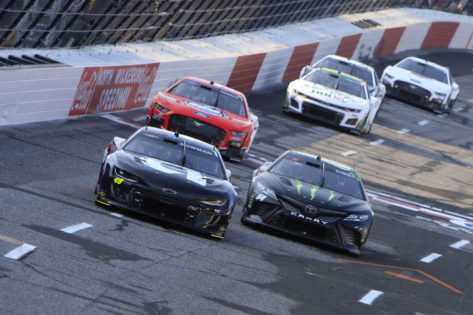From its wild beginnings at Charlotte Motor Speedway in 1985, the NASCAR All-Star Race has always been a spectacle built for drama and unpredictability. With no points on the line and a winner-take-all purse, it’s delivered legendary moments like Dale Earnhardt’s “Pass in the Grass” in 1987 and the infamous Rusty Wallace-Darrell Waltrip clash in 1989.
Over the years, the event has bounced between tracks and formats, but one thing never changes: it’s where NASCAR lets loose, experiments, and puts entertainment front and center. But not every idea makes the cut. And as this year’s hype builds, a long-standing debate resurfaces: how far is too far when you’re chasing entertainment? A well-known insider just weighed in, clearing the air on what the All-Star Race really is… and isn’t.
“This is an entertainment business. Bottom line,” the PRN host reminded fans during a recent segment. And nowhere is that philosophy more visible than in NASCAR’s All-Star Race. Unlike points-paying weekends, the All-Star event exists solely to thrill. It’s non-traditional, experimental, and risk-friendly. The race gives NASCAR the flexibility to shake things up without impacting championship standings.
Some of NASCAR’s most impactful rule changes debuted at the All-Star Race. “You got to remember one thing. This is an entertainment business. Bottom line. We are in the entertainment business. And this is a strictly entertainment race. No points on the line. Doesn’t work towards a championship or anything. We’ve seen the all-star race used a lot of times to experiment with something that ended up being part of the sport. The double file restart. The option tire. The choose rule.”
The double-file restart, first tested in 2009, transformed restarts by lining up lead-lap cars side-by-side, eliminating lapped traffic from the front and intensifying late-race battles. This fan-favorite tweak was so successful that it became standard in just weeks, dramatically increasing on-track excitement.
Other innovations, like the option tire and the choose rule, also began at the All-Star Race. The choose rule, now a staple, lets drivers pick their preferred restart lane, adding a layer of strategy and unpredictability. These changes have roots in the All-Star’s role as NASCAR’s “beta test platform,” where entertainment and experimentation go hand in hand.
Recently, a ‘run what you brung’ concept, essentially, no rules on car builds, was floated for the All-Star event. However, the idea was rejected outright. PRN’s host revealed, “I don’t want to see this in a regular event. The one idea that was floated apparently was basically the no rules brung what you got and that apparently got shot down by the team because they said it would be cost-prohibitive.
Simply put, was the concept good on paper? Of course! NASCAR has problems with its short-track formula and this could have helped solve it. Even Hamlin knew that when he opposed the idea. He said, “Generally speaking, if you’re just talking to me, the racecar driver and the fan, I’m gonna say, ‘Damn, I wish we had this.’ This would be fantastic. There could possibly be something that gets learned for the short-track package that could make it better.”
However, the expenses are real. Next-Gen components don’t come cheap, and when Denny Hamlin countered the proposal, saying it could cost upwards of $2 million, NASCAR’s Mike Forde, speaking on the Hauler Talk podcast, took a jab at Hamlin. “I think his math was off by about two million dollars.” The problem does exist. As Dale Earnhardt put it, “Give us real flexibility, real changes. Not a one-time lab test that no one can afford.”
The economics of running a NASCAR team
Denny Hamlin’s warning about the cost of “run what you brung” reflects a deeper truth: NASCAR is now as much about economics as engineering. The days when a small group could start a Cup team from a garage are gone. Today, buying a single charter, the ticket to guaranteed race entry, can cost up to $40 million, as Spire Motorsports paid this offseason.
Building and maintaining a competitive car is another major expense. A fully built Next Gen car costs around $350,000 to $400,000, and teams need several for a season. Factoring in repairs, crashes, and upgrades, running one car for a full season can easily top $15 million, even before adding salaries, travel, and logistics. Weekly payroll for mechanics, engineers, pit crews, and support staff can exceed $83,000, while travel and lodging add thousands more per race.
As Hamlin put it, “Who’s going to pay for it? It’s because the teams don’t have enough money,” Hamlin said. “This is what we’re fighting for. This is what we’ve been talking about. If you continue to lose money year after year, why would you just raise your hand and say, ‘Sure, I’ll take another million loss, give me a million? I’ll take a million loss.’ You can’t do that. It’s not sustainable.”
To offset these expenses, teams rely heavily on sponsorships and their share of NASCAR’s media revenue. In 2023, Team Penske led the field with $141 million in sponsorship. But even powerhouse teams saw revenue volatility in 2024 and 2025. The new $1.1 billion annual media deal gives teams a larger slice, but they still push for a bigger share as costs rise.
As NASCAR restructures and teams demand greater profitability and enterprise value, the economics of racing are under the microscope. Will the series’ new financial model finally align the interests of teams, tracks, and the sanctioning body? Or will the cost of competition continue to outpace the rewards and innovation?
The post “This Is Entertainment” — NASCAR Insider Defends Bold Team Rejection Of Costly All-Star Gimmick appeared first on EssentiallySports.
